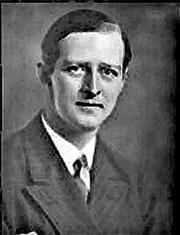Nationality American Name Henry Field | Role Anthropologist | |
 | ||
Institutions Field Museum of Natural History; Peabody Museum of Archaeology and Ethnology at Harvard University; University of Miami Books The Anthropology of Iraq, Arabs of Central Iraq: Thei, Body‑marking in southwes, Ancient and modern, An Anthropological Reconnai | ||
Henry Field (December 15, 1902 – January 4, 1986) was an American anthropologist and archaeologist.
Contents
Henry Field was born in Chicago. He was a great nephew of the merchant Marshall Field and a great nephew of Barbour Lathrop. Field grew up at Baggrave Hall, Hungarton, Leicestershire, England and he was educated at Sunningdale, Eton, and Oxford (B.A., 1925; M.A., 1930; D.Sc., 1937).
Early career
After being awarded his B.A., Field moved back to Chicago in 1926 to begin working for the Field Museum of Natural History in Chicago as assistant curator of physical anthropology. Field's first participation in an expedition was in the University of Oxford/Field Museum excavation of Kish. His work included 5000 photographs of the excavations and portraits of the modern villagers. Beginning in the late 1920s the Field Museum began planning for the upcoming Chicago World's Fair. Field supervised the creation of two permanent exhibitions. The "Hall of Prehistoric Man" had nine full-size dioramas of early life augmented by artifacts collected by Field. The "Hall of the Races of Mankind" had over 100 full sized sculptures of different races by the renowned sculptor Malvina Hoffman. The exhibitions were ready on time for the opening of the fair, the Century of Progress, on 30 May 1933. In 1934 Field was promoted to Head Curator of physical anthropology. One important acquisition Field made for the Museum was "Magdalenian Girl" which is still on display today and remains the most complete Upper Paleolithic skeleton available for study in North America. Field went back to Iraq in 1934 and made anthropometic surveys of Marsh Arabs, Shammar bedouins, and Kurds.
World War II
In 1941, just before America's entry into the Second World War, Field was asked to be the "Anthropologist to the President" by president Roosevelt and to be a member of the Special Intelligence Unit of the White House to direct a top-secret "M" ("M" for migration) project. The President believed that refugee migration and re-settlement in areas where they would be given asylum and be able to thrive would be one of the biggest issues of the post-war era. He wanted Field to look at under-populated areas in North Africa and the Middle East as possible sites for their resettlement. Over 600 studies were produced. Complete sets are held in several libraries including the Franklin D. Roosevelt Library at Hyde Park, NY and the University of Miami.
Later career
Field was a Research Fellow at the Peabody Museum of Archaeology and Ethnology at Harvard University from 1950 to 1969. He was a member of the University of California African Expedition (1947–48), and the Peabody Museum- Harvard Expedition to the Near East and Pakistan. He moved to Coconut Grove, Florida in the early 1950s and taught at the University of Miami beginning in 1966. Doubleday published his autobiography,The Track of Man, in 1952. In Coconut Grove he ran Field Research Projects, a publisher of scientific and educational materials. His third wife, Julia Allen Field was a lion trainer, zoo director, and environmental planner in Columbia. Field has two daughters: Mariana Field Hoppin of New York and Juliana Field of Framingham, Massachusetts. He died in Coral Gables in 1986.
The Special Collections department of the University of Miami library holds 35 boxes of the papers of Henry Field relating to the "M" project and several archaeology expeditions. In 2004-2005 The Peabody Museum of Archaeology and Ethnology at Harvard University put on an exhibition titled Field Photography, 1934, The Marsh Arabs of Iraq. This consisted of photographs taken during the Field Museum's Near East Expedition led by Henry Field in 1934. The world's attention was focused on the Marsh Arabs when Saddam Hussein began a genocide against these people in 1991 but after the end of the Iraq War they have begun coming back.
